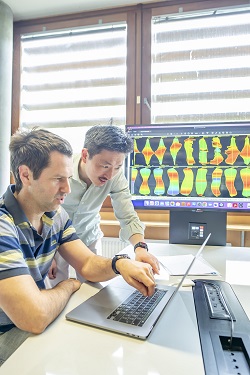University of Nottingham, UK
To provide participants with an introduction to the field of interactive data visualization with a special emphasis on storytelling. Participants will learn the major challenges in the field as well as the current state-of-the-art in storytelling and visualization.
The tutorial consists of three parts:
Part 1: Introduction and Overview
Part 1 provides a general introduction to the field of interactive Data Visualization. The main motivation as well as example applications are presented. New terminology is introduce as well as some of the major subfields. Visualization goals, advantages, and disadvantages are presented. The visualization pipeline is described. Varying characteristics of data are presented.
Part 2: The State-of-the-Art in Storytelling and Visualization
Throughout history, storytelling has been an effective way of conveying information and knowledge. In the field of visualization, storytelling is rapidly gaining momentum and evolving cutting-edge techniques that enhance understanding. Many communities have commented on the importance of storytelling in data visualization. Storytellers tend to be integrating complex visualizations into their narratives in growing numbers. In part 2, we present the state-of-the-art in storytelling literature in visualization and present an overview of the common and important elements in storytelling visualization. We also describe the challenges in this field as well as a novel classification of the literature on storytelling in visualization. Our classification scheme highlights the open and unsolved problems in this field as well as the more mature storytelling sub-fields. The benefits offer a concise overview and a starting point into this rapidly evolving research trend and provide a deeper understanding of this topic.
Part 3: Visualization Resources
Visualization, a vibrant field for researchers, practitioners, and higher educational institutions, is growing and evolving very rapidly. Tremendous progress has been made since 1987, the year often cited as the beginning of data visualization as a distinct field. As such, the number of visualization resources and the demand for those resources is increasing at a rapid pace. In part 3, we present open visualization resources for all those with interested in carrying on with research in interactive data visualization and visual analytics. Because the number of resources is so large, we focus on collections of resources, of which there are already many ranging from literature collections to collections of practitioner resources. Based on this, we develop a classification of visualization resource collections with a focus on the resource type, e.g. literature-based, web-based, developer focused and special topics. The result is an overview and details-on-demand of many useful resources. The collection offers a valuable jump-start for those seeking out data visualization resources from all backgrounds spanning from beginners such as students to teachers, practitioners, developers and researchers wishing to create their own advanced or novel visual designs. This part is a response to students and others who frequently ask for visualisation resources available to them.
PhD candidates, researchers, and students with an interest in interactive Data Visualization.
A laptop with WiFI access. We will carry out some exercises as part of the tutorial so bringing a laptop is helpful. For those with no laptops, exercises can be done in pairs or small groups.

Robert S. Laramee received a bachelors degree in physics, cum laude, from the University of Massachusetts, Amherst. He received a masters degree in computer science from the University of New Hampshire, Durham. He was awarded a PhD from the Vienna University of Technology, Austria at the Institute of Computer Graphics and Algorithms. From 2001 to 2006 he was a researcher at the VRVis Research Center and a software engineer at AVL in the department of Advanced Simulation Technologies. Previously he was an Associate Professor at Swansea University (Prifysgol Cymru Abertawe), Wales in the Department of Computer Science (Adran Gwyddor Cyfrifiadur). He joined Nottingham University, School of Computer Science as an Associate Professor in 2020. His research interests are in the areas of big data visualization, visual analytics, and data science.
He has published more than 190 peer-reviewed papers in scientific conferences and journals. For more information, please visit:
http://www.cs.nott.ac.uk/blaramee/
References
Chao Tong and Robert S Laramee, From Data Chaos to the Visualization Cosmos, book chapter in Computer Graphics and Imaging IntechOpen Publishers, 2019, ISBN 978-1-83962-283-0, http://dx.doi.org/10.5772/intechopen.82159
Chao Tong, Richard Roberts, Rita Borgo, Sean Walton, Robert S Laramee, Kodzo Wegba, Aidong Lu, Yun Wang, Huamin Qu, Qiong Luo, and Xiaojuan Ma, Storytelling and Visualization: An Extended Survey, Information, Volume 9, Number 3, March 2018, file https://doi.org/10.3390/info9030065
Xiaoxiao Liu, Mohammed Alharbi, Jian Chen, Alexandra Diehl, Elif E Firat, Dylan Rees, Qiru Wang, and Robert S Laramee, Visualization Resources: A Survey, Information Visualization, https://doi.org/10.1177/14738716221126992
YouTube Channel with full Data Visualization course:
https://youtube.com/playlist?list=PLZo40sVmw_4No1_K-Xllf04O977PYngq1